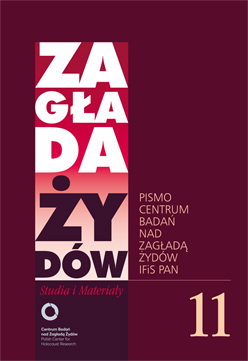Źródła ukazujące działalność batalionów policyjnych w okupowanej Polsce
Sources Showing the Activity of Police Battalions in Occupied Poland
Author(s): Stefan KlempSubject(s): History, Recent History (1900 till today), WW II and following years (1940 - 1949)
Published by: Stowarzyszenie Centrum Badań nad Zagładą Żydów & IFiS PAN
Keywords: sources for research on Ordnungspolizei and Schutzpolizei
Summary/Abstract: Contrary to Waffen SS and Kriminalpolizei, for many years after the war Ordnungspolizei and Schutzpolizei were not deemed criminal organisations. Finally, in the 1990s Christopher Browning and Daniel Goldhagen publicized the crimes committed by the police battalions. But the involvement of many high rank police functionaries and oficers in, for instance, Aktion Reinhardt or Aktion Erntefest remains insufficiently examined and described. The author of the article presents the content of the dispersed body of sources for research on police battalions. It contains files of postwar investigations conducted by the Dortmund, Ludwigsburg, and Coblenz public persecution services, the Kriminalpolizei documentation in the State Archive in Münster and Duisburg, documentation od the Stasi Records Agency, denaziication proceedings iles, and records of the Nazi Documentation Centre, the Wehrmacht Information Bureau in Berlin, the Military Archive in Freiburg, and others. The author discusses both the potential and the limitations of these sources. Using the example of Erich Steidtmann, she shows the German judiciary’s reluctance to prosecute those crimes, as police oficer Steidtmann avoided charges even though in 1963 during his interrogation as a witness he admitted his participation in anti-Jewish campaigns in Warsaw. The documents which the author used to reconstruct Steidtmann’s biography show the whole spectrum of issues connected with using the said body of sources: they not only describe historic events, but also show the pursuit of criminals, the possibilities of covering up the crimes, and the mistakes and negligence during the post-war investigations. Nonetheless, if one makes an effort to ind, compare, and link the dispersed information from the investigation iles (witness testimonies), personal documents, and historical publications, it is possible to accurately reconstruct the biographies of Ordnungspolizei and Schutzpolizei functionaries and determine their role in the Holocaust.
Journal: Zagłada Żydów. Studia i Materiały
- Issue Year: 2015
- Issue No: 11
- Page Range: 271-298
- Page Count: 28
- Language: Polish

